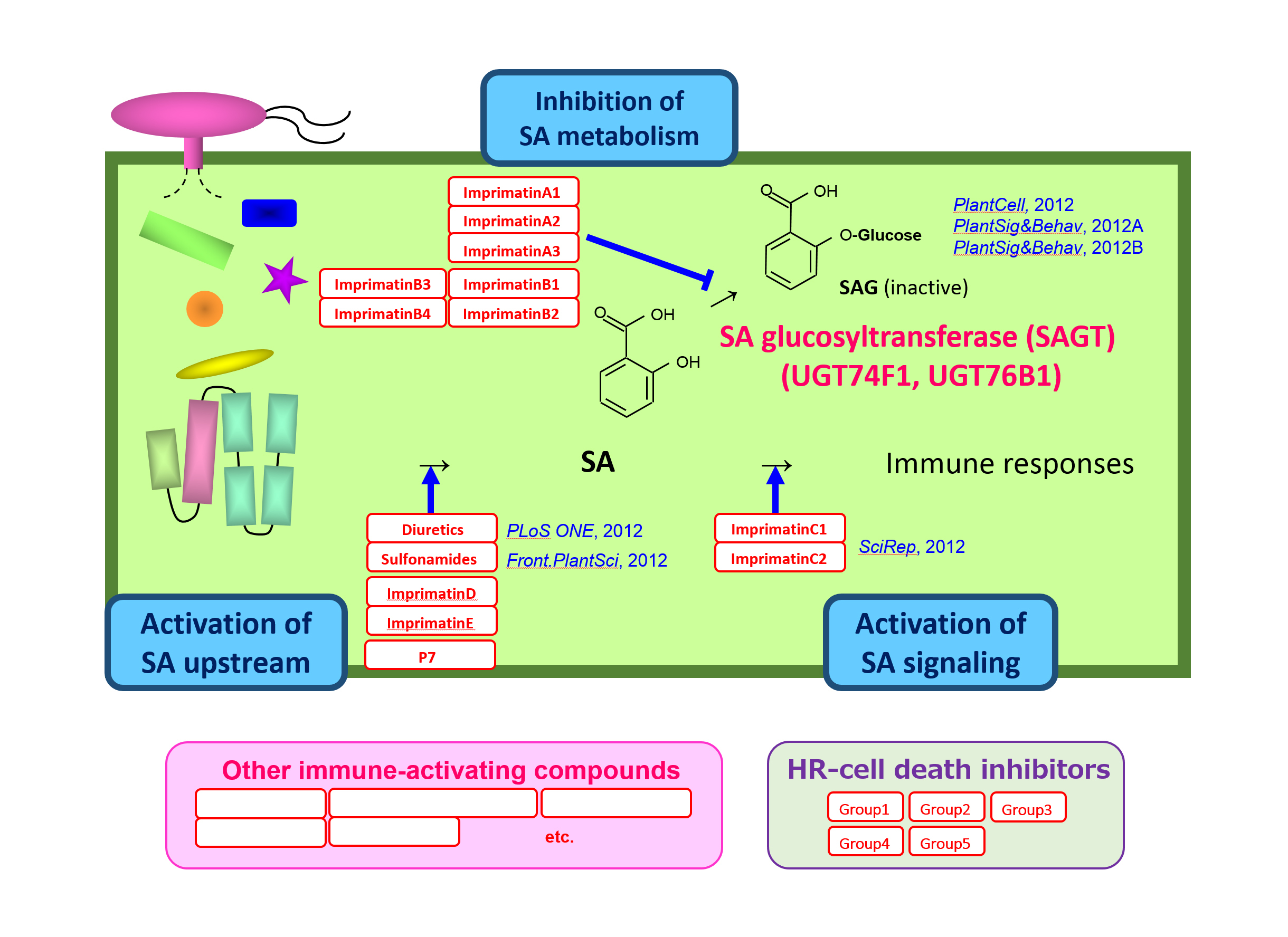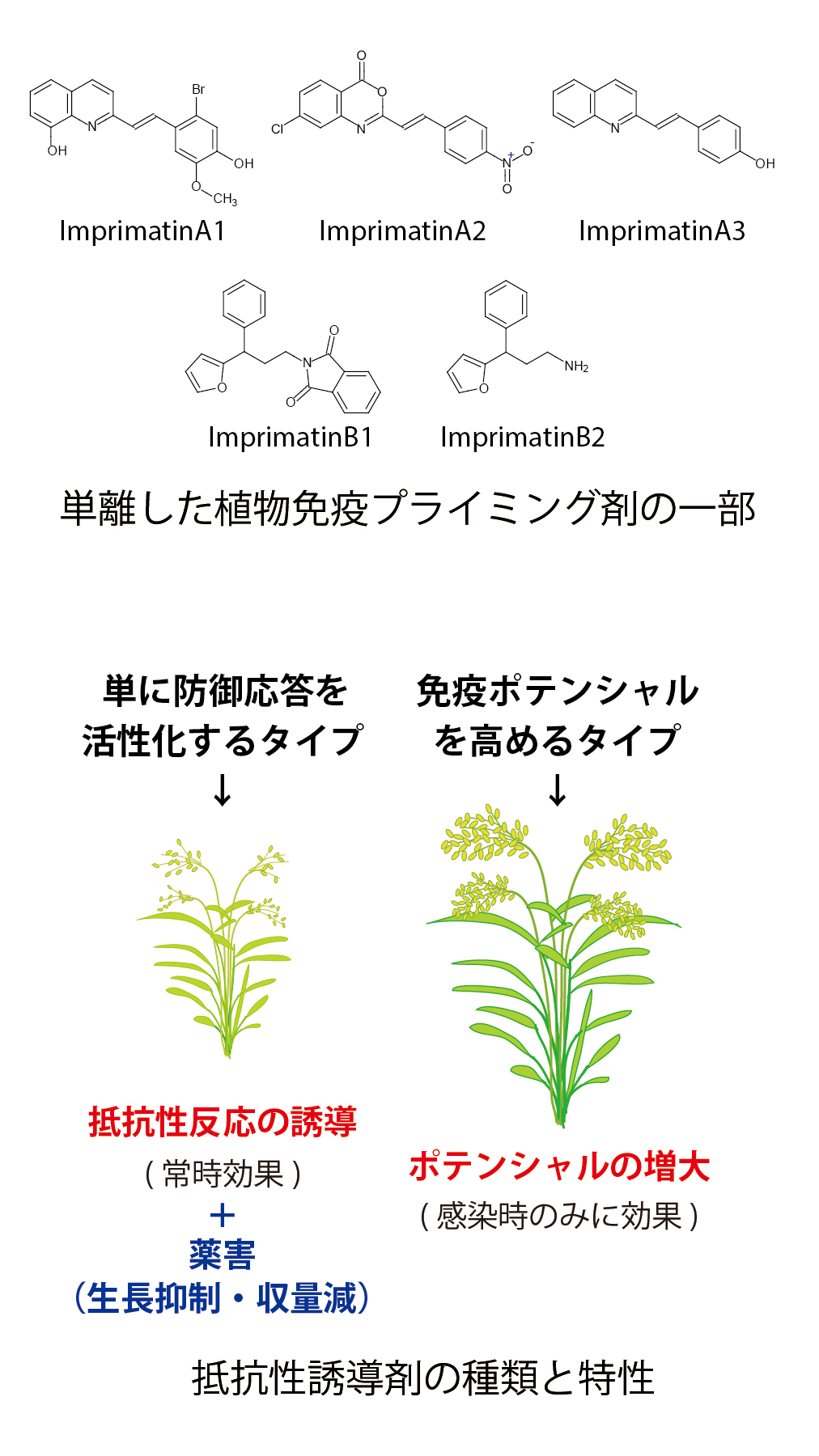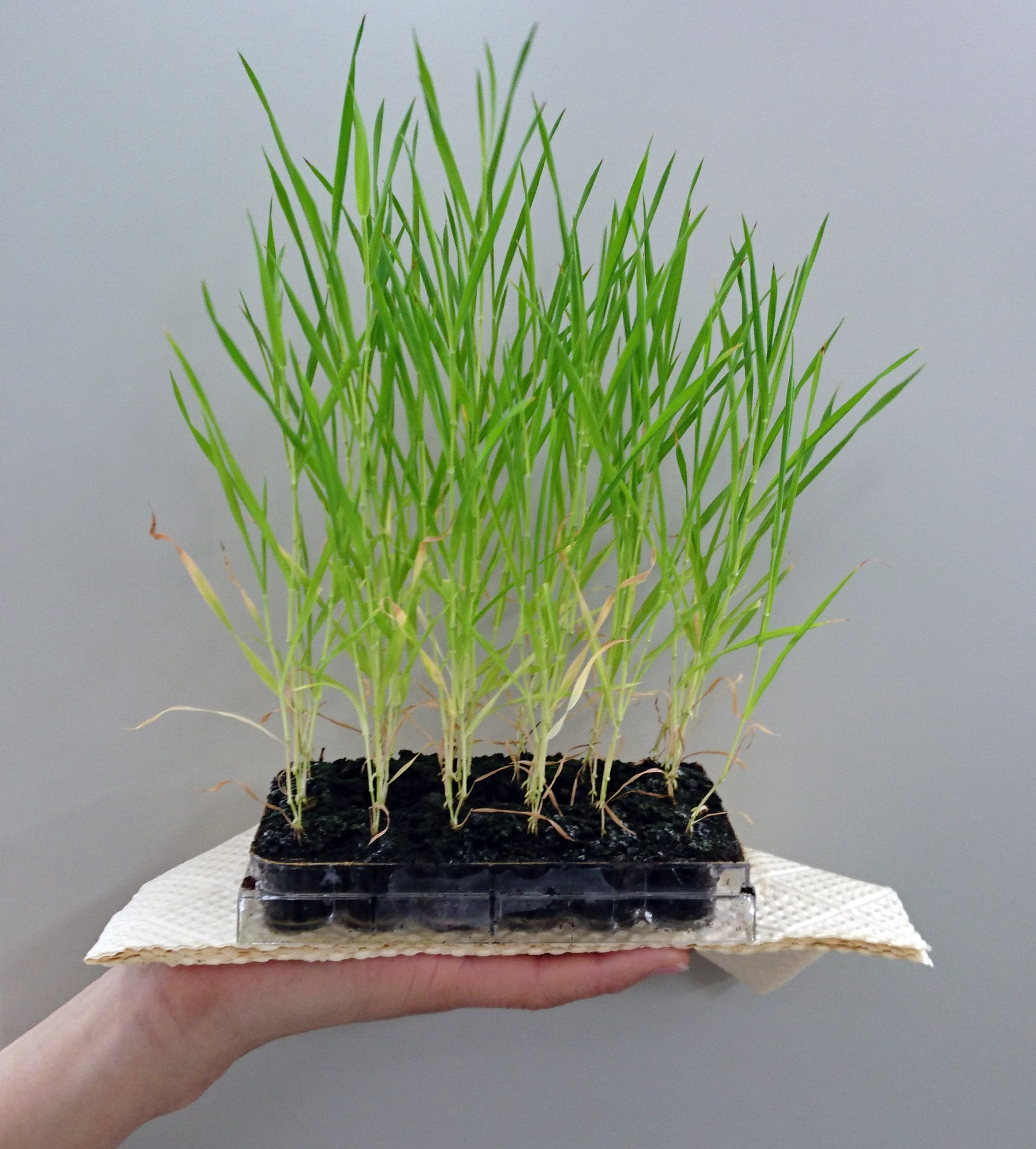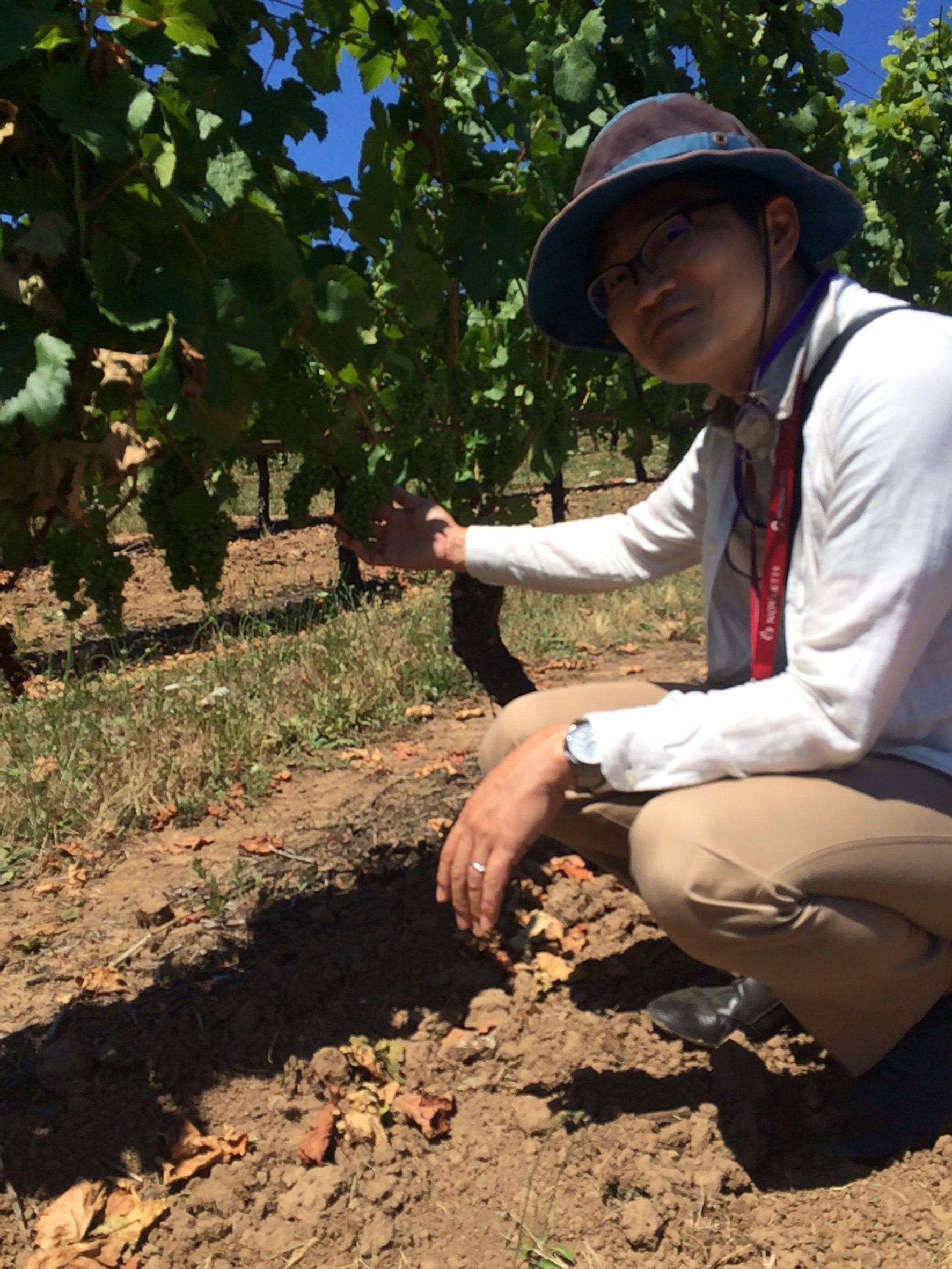Research projects
1. Chemical biology approach for plant immunity system
2. Development of plant defense activator, immune-priming compound
3. Model pathosystem for sheath blight disease using Rhizoctonia solani and Brachypodium distachyon
4. Suppression mechanism of a biocontrol bacterial agent for Rhizobium vitis
1. Chemical biology apporoach for plant immunity system
Human beings have used crop protection methods such as disease resistant varieties and pesticides. Recently, recombination technology are used to confer disease resistance or tolerance to crops. The current crop production is maintained by full use of these approaches. In order to further improve the situation, development of new methodology based on novel approaches are required. To create technological innovation, the understanding of both pathogen infection strategy and the plant immune mechanism at molecular levels are needed.
To identify genes involved in plant immunity, genetics approach have been used for long time. From populations with randomly mutagenized genome DNA, mutants which show abnormal immune response are selected and then the causal genes can be identified as candidates for new immune components. DNA mutations make amino acid substitution or truncation of proteins leading to phenotypes.
In chemical biology (chemical genetics), chemical compounds are used instead of a DNA mutation to inhibits or enhances the function of proteins, as a substance of gene, that can produce phenotypes. The compounds which affect specific biological phenomena are used to identify proteinaceous players as targets. The advantage of this approach is that it can identify essential genes or functionally redundant genes since the bioactive molecules can be applied in particular timings or concentrations.
We have developed an high-throughput assay system that can quantitatively evaluate a immune response of plant cell called hypersensitive cell death after pathogen infection. This enables screening for the agents that inhibit or enhance plant immune responses from libraries of the various compounds. We isolated a large number of immune inhibitors and potentiators. By analyzing their action mechanisms, we are now trying to identify their action mechanisms to understand disease resistance response and the defense-activating approaches in plants.
Reference:
Frontiers in Plant Science
When Chemistry meets Biology – Generating Innovative Concepts, Methods and Tools for Scientific Discovery in the Plant Sciences


2. Development of plant defense activator, immune-priming compound
Bioactive small molecules that enhance immune responses in plants can be used not only as a tool for fundamental biological research but also as potential lead compounds to develop disease resistance inducer (plant defense activator). Such agrochemicals exert crop protection activity from diseases by increasing plant immunity. They are effective to broad range of diseases and have no risk of emergence of drug-resistant pests since they act on plants and do not give any selective pressure on pathogens. In fact, probenazole (Oryzemate®) has been used for almost 40 years in rice cultivation but it has not yet been broken by drug-resistant pathogens.
Pesticides are necessary in order to maximize the performance of agricultural farming. Nowadays the target of pesticides has become more specific to particular pathogen molecules in consideration of safety, therefore, they may be occasionally broken down by drug resistance pathogens. As a result, agents that can be used in the agricultural field are getting exhausted. In that respect, plant defense activators are expected to be an alternative means for crop protection. In addition, it can contribute to reduction of agricultural work and environmental burden by reducing the amount of pesticides.
Probenazole was found by chance in the process of pesticide screening. The other practically used plant defense activators were identified from derivatives inspired by known molecules. All the existing products are optimized for rice blast. To apply plant defense activators to other crop diseases, novel lead compounds are required. Since our screening system uses A. thaliana, a model of dicotyledonous plant, we expect that new plant immune-activating molecules with unique feature can be isolated. Strong induction of defense responses in plants often associates with growth retardation. Therefore, plant immune-priming molecules may be suitable for the development of practical agrochemicals compared with plant defense inducers. Our screening method can selectively identify immune-priming chemicals and characterization of the isolated molecules named imprimatin have been reported.
RIKEN RESEARCH
3. Model pathosystem for sheath blight disease using R. solani and B. distachyon
Sheath blight is one of the serious diseases in rice as blast disease. The causal agent of this disease is Rhizoctonia solani, a pathogenic soil-borne filamentous fungus. The infested hyphae produce a mass of mycelium called sclerotium which falls to the ground and overwinters. When paddy field is filled with water, the floated sclerotia attach to rice sheath and infection process begins from the edge of water. Oval lesion spots appear and then fungal hyphae spread to not only upper part but also surrounding plants in summer. Quality of rice grain is decreased and lodging causes a reduction in yield. There are no strong disease resistant cultivars in both cultivated and wild rice to this pathogen, so pesticides are the only control method in the field.
R. solani can infect more than 200 plant species and is also known as causal agents of stem or root rot diseases in various kind of crops. High humidity and temperature are favorable condition for the growth of this fungi, therefore, expansion of Rhizoctonia diseases in future is forecasted due to global warming. In general, to overcome crop disease, understanding of pathogen’s virulence mechanism is required. However, it is still unclear in R. solani because genetic approach cannot be applied due to its multinucleate nature.
We developed an experimental pathosystem for the molecular pathological analysis of R. solani using a model monocotyledomous plant Brachypodium distachyon. Since R. solani can infect broad range of plants and produces severe necrotic lesions, it is classified into necrotrophic pathogen which kills host cells and derive nutrients from dead tissues. On the other hand, biotrophic pathogens build specific infection machineries by using cellular biological process of living host cells to exploit nutrients. Some phytopathogens are hemibiotroph whose infection process initiates biotrophically before shifting later necrotrophic stage. We found that pretreatment of a phytohormone salicylic acid conferred disease resistance in B. distachyon against sheath blight disease by R. solani. Salicylic acid is known to induce defense responses effective to biotrophic stage. Our result suggests that R. solani should use biotrophic process at its early infection stage. We also identify two B. distachyon accessions which are resistant to R. solani. Since they activate SA-dependent signaling pathway after infection of R. solani, their disease resistance proteins may specifically recognize effector proteins released from R. solani at the early infection stage to invoke strong disease resistance response.
We are now trying to identify R. solani effectors and its cognate R gene in B. distachyon.
Plant science: New insights into infection strategy of Rhizoctonia solani, a causal agent for rice sheath blight, highlighted by the plant defense mechanism. OKAYAMA UNIV. e-Bulletin (2018) Vol.21, pp11-13. Link


4. Suppression mechanism of a biocontrol bacterial agent for crown gall disease
Grape is one of the main agricultural products in Okayama prefecture, Japan. Since grapevine is important for not only fresh fruit but also wine, it is growing in the world. Grape production is suffering severe agricultural damage from crown gall disease. The causal agent of this disease is a phytopathogenic soil-borne bacterium, Rhizobium (synonym: Agrobacterium) vitis. It invades from the wounded root and reaches everywhere in the body through vessel. This pathogen promotes the gall formation by transferring its own DNA into the nucleus of host plant cell which makes plant produce phytohormones and nutrients for pathogen. The galls decrease host viability leading to death of the tree.
Pesticide spraying is ineffective to soil-borne diseases. Biological control is therefore used as an alternative methodology for crop protection from diseases. Dr. Akira Kawaguchi has isolated antagonistic bacterial strains from grapevine root which can suppress the crown gall formation in grape. Pretreatment of plant root with the bacterial suspension significantly suppress the disease. These antagonistic bacteria belong to the genus Rhizobium vitis which is the same as pathogenic bacterium but they do not carry the Ti plasmid required for tumor induction. These antagonistic microorganisms are generally thought to exert crop protection activity via habitat competition with pathogens, antibiotic activity, defense-induction in host, and/or plant growth promoting activities.
Their disease suppression activities are so strong but its molecular mechanism remains unclear. We are now investigating it in collaboration with Dr. Kawaguchi. If we understand the mechanism, we can develop screening method to identify more effective strains which can be applied in other crops.
So far, we found that the antagonistic activity of the bacterium is in the supernatant. Furthermore, it was detected in the high-molecular weight fraction and it is also sensitive to heat treatment.
Characterization of the suppressive effects of the biological control strain VAR03-1 of Rhizobium vitis on the virulence of tumorigenic R. vitis
Journal of General Plant Pathology (2018) 84:58-64. Link
We finallly revealed the molecular mechanism underlying the biocontrol activity.
Rhizoviticin is an alphaproteobacterial tailocin that mediates biocontrol activity of grapevine crown gall disease
The ISME Journal (2024) 18(1), wrad003. Link

